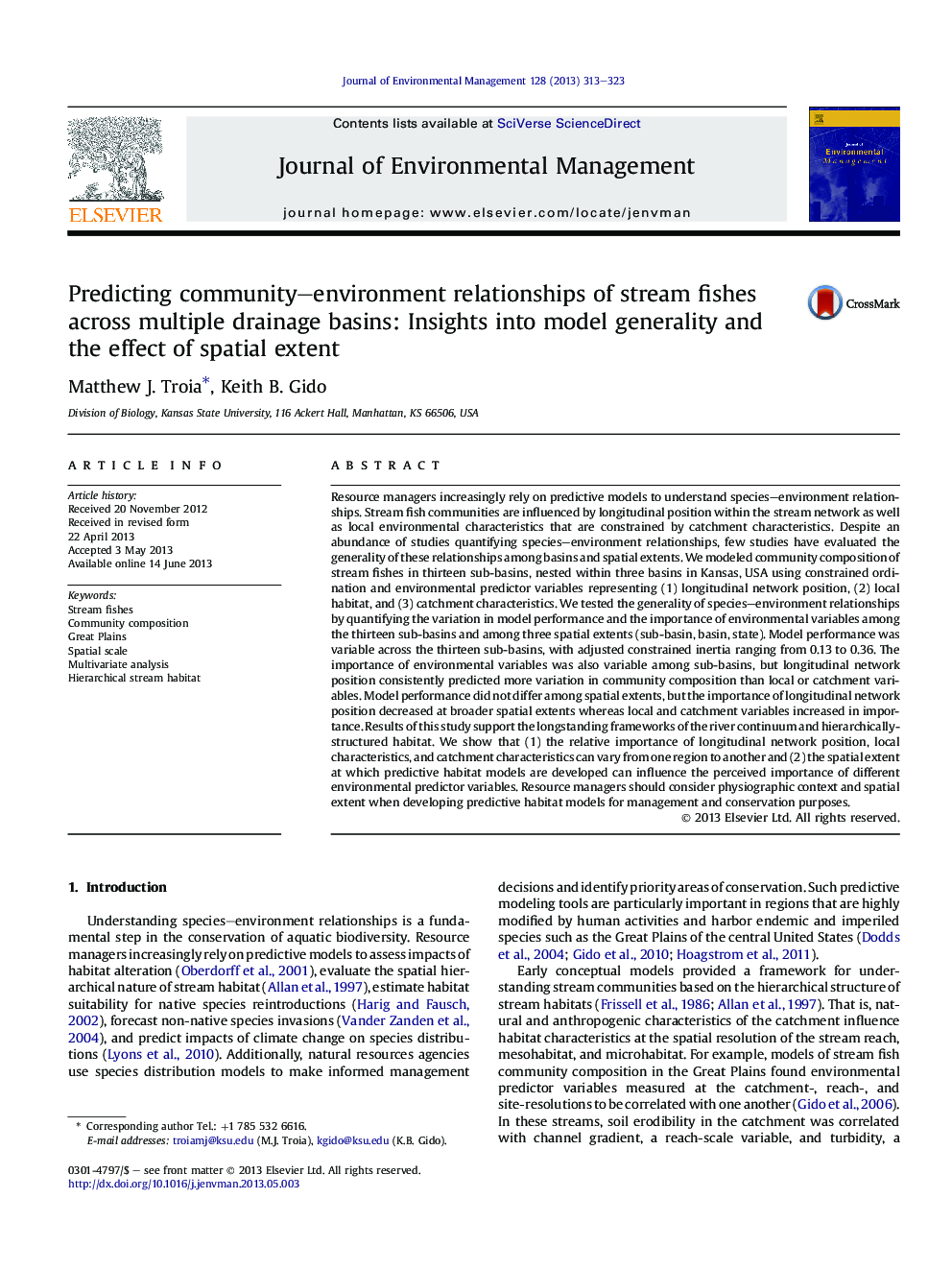| کد مقاله | کد نشریه | سال انتشار | مقاله انگلیسی | نسخه تمام متن |
|---|---|---|---|---|
| 7484331 | 1485284 | 2013 | 11 صفحه PDF | دانلود رایگان |
عنوان انگلیسی مقاله ISI
Predicting community-environment relationships of stream fishes across multiple drainage basins: Insights into model generality and the effect of spatial extent
ترجمه فارسی عنوان
پیش بینی روابط محیطی جامعه از جریان ماهی در حوضه های مختلف زهکشی: بینش به عمومیت مدل و اثر محدوده فضایی
دانلود مقاله + سفارش ترجمه
دانلود مقاله ISI انگلیسی
رایگان برای ایرانیان
کلمات کلیدی
جریان ماهی ترکیب جامعه، دشت های بزرگ، مقیاس فضایی، تجزیه و تحلیل چند متغیره، زیستگاه جریان سلسله مراتبی،
ترجمه چکیده
مدیران منابع به طور فزاینده ای بر مدل های پیش بینی شده برای درک روابط بین گونه های محیطی متکی هستند. جوامع جریان ماهی تحت تأثیر موقعیت طولی درون شبکه جریان و همچنین ویژگی های محیطی محلی قرار دارند که با ویژگی های آبریز محدود می شوند. علیرغم فراوانی مطالعاتی که مقدار روابط محیط زیستی را تعیین می کنند، مطالعات اندکی به بررسی کلی این روابط بین حوضه ها و دامنه های فضایی پرداخته اند. ما مدل ترکیب جامعه ماهی های جریان در سیزده زیر حوضه ها، در سه کانتینر کانزاس، ایالات متحده آمریکا با استفاده از محدودیت های مختلط و متغیر پیش بینی متغیر (1) موقعیت شبکه طولی، (2) زیستگاه های محلی و (3) ویژگی های آبریز توزیع شده است. ما با تعیین مقدار تغییرات در عملکرد مدل و اهمیت متغیرهای محیطی در میان سیزده زیر حوضه و در میان سه محدوده فضایی (حوزه آبخیز، حوضه، حوضه)، کلیت روابط محیط زیست-محیطی را مورد آزمایش قرار دادیم. عملکرد مدل در سیزده زیر حوضه متغیر بود و اینرسی با محدودیت تنظیم شده از 0.13 تا 0.36 متغیر بود. اهمیت متغیرهای محیطی نیز در بین حوزه های زیر متغیر بود، اما موقعیت شبکه طولی به طور مداوم تغییرات بیشتری را در ترکیب جامعه پیش بینی می کرد تا متغیرهای محلی یا حوضه. عملکرد مدل در محدوده فضایی تفاوت نداشت، اما اهمیت موقعیت طولی شبکه در ابعاد وسیعتر فضایی کاهش یافت در حالیکه متغیرهای محلی و حوضه ای در اهمیت افزایش یافت. نتایج این مطالعه از چارچوب طولانی مدت پیوستگی رودخانه و زیستگاه سلسله مراتبی سازه پشتیبانی می کند. ما نشان می دهد که (1) اهمیت نسبی موقعیت شبکه طولی، ویژگی های محلی و ویژگی های آبریز از یک منطقه به یک دیگر متفاوت است و (2) محدوده فضایی که در آن مدل های زیستگاه پیش بینی شده توسعه می تواند بر اهمیت ادراک شده پیش بینی محیط زیست متغیرها مدیران منابع در هنگام ایجاد مدل های پیش بینی زیستگاه برای اهداف مدیریت و حفاظت باید فضای زمینه فیزیوگرافی و محدوده فضایی را در نظر بگیرند.
موضوعات مرتبط
مهندسی و علوم پایه
مهندسی انرژی
انرژی های تجدید پذیر، توسعه پایدار و محیط زیست
چکیده انگلیسی
Resource managers increasingly rely on predictive models to understand species-environment relationships. Stream fish communities are influenced by longitudinal position within the stream network as well as local environmental characteristics that are constrained by catchment characteristics. Despite an abundance of studies quantifying species-environment relationships, few studies have evaluated the generality of these relationships among basins and spatial extents. We modeled community composition of stream fishes in thirteen sub-basins, nested within three basins in Kansas, USA using constrained ordination and environmental predictor variables representing (1) longitudinal network position, (2) local habitat, and (3) catchment characteristics. We tested the generality of species-environment relationships by quantifying the variation in model performance and the importance of environmental variables among the thirteen sub-basins and among three spatial extents (sub-basin, basin, state). Model performance was variable across the thirteen sub-basins, with adjusted constrained inertia ranging from 0.13 to 0.36. The importance of environmental variables was also variable among sub-basins, but longitudinal network position consistently predicted more variation in community composition than local or catchment variables. Model performance did not differ among spatial extents, but the importance of longitudinal network position decreased at broader spatial extents whereas local and catchment variables increased in importance. Results of this study support the longstanding frameworks of the river continuum and hierarchically-structured habitat. We show that (1) the relative importance of longitudinal network position, local characteristics, and catchment characteristics can vary from one region to another and (2) the spatial extent at which predictive habitat models are developed can influence the perceived importance of different environmental predictor variables. Resource managers should consider physiographic context and spatial extent when developing predictive habitat models for management and conservation purposes.
ناشر
Database: Elsevier - ScienceDirect (ساینس دایرکت)
Journal: Journal of Environmental Management - Volume 128, 15 October 2013, Pages 313-323
Journal: Journal of Environmental Management - Volume 128, 15 October 2013, Pages 313-323
نویسندگان
Matthew J. Troia, Keith B. Gido,
